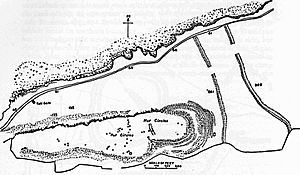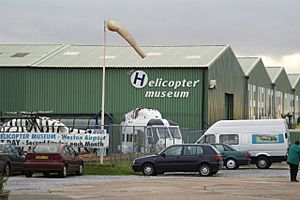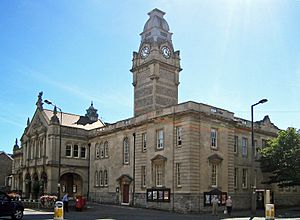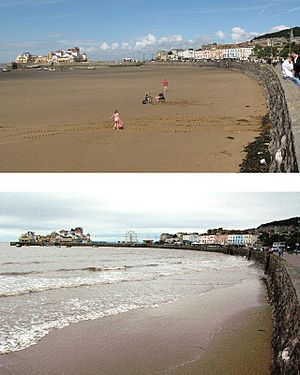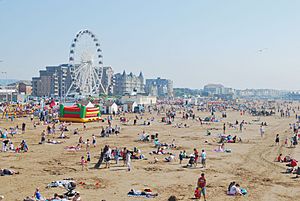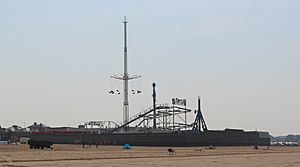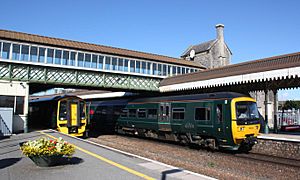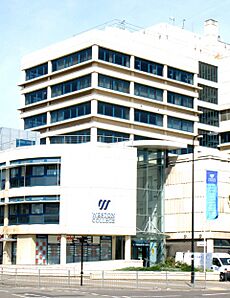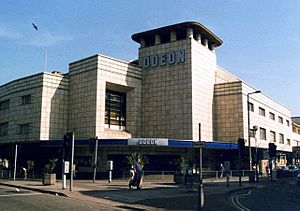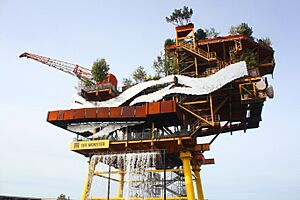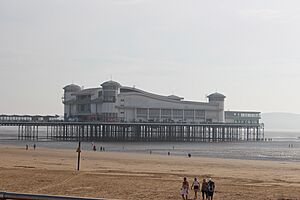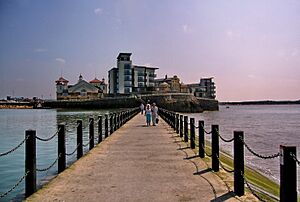Weston-super-Mare facts for kids
Quick facts for kids Weston-super-Mare |
|
|---|---|
|
From the top to bottom-right, Weston-super-Mare beach, Winter Gardens Pavilion, Town Hall, Blakehay Theatre, Grand Pier
|
|
| Population | 82,418 (2021 Census) |
| Demonym | Westonian |
| OS grid reference | ST320613 |
| Civil parish |
|
| Unitary authority | |
| Ceremonial county | |
| Region | |
| Country | England |
| Sovereign state | United Kingdom |
| Post town | WESTON-SUPER-MARE |
| Postcode district | BS22–BS24 |
| Dialling code | 01934 |
| Police | Avon and Somerset |
| Fire | Avon |
| Ambulance | Great Western |
| EU Parliament | South West England |
| UK Parliament |
|
Weston-super-Mare (/ ... ˈmɛər/ ..._-mair) is a lively seaside town and civil parish in England. It's located in the North Somerset area, right by the Bristol Channel. The town is about 20 miles (32 km) southwest of Bristol, nestled between Worlebury Hill and Bleadon Hill. In 2021, about 82,418 people lived here.
This area has been home to people since the Iron Age. For a long time, Weston was just a small village. But in the 1800s, it grew into a popular seaside resort. A railway station and two piers were built to welcome visitors. Later, the M5 motorway connected the town, making it easier to reach. Even though fewer people stay for long holidays now, many still visit for a day trip.
Some of the town's cool attractions include the Grand Pier, Weston Museum, and The Helicopter Museum. You can also enjoy shows at places like The Playhouse, the Winter Gardens, and the Blakehay Theatre.
The Bristol Channel has the world's second-biggest tide changes! At low tide, the sea in Weston Bay can be about 1 mile (1.6 km) away from the shore. The beach is sandy, but be careful at low tide, as thick mud can appear and be dangerous. The River Axe flows into the sea at the south end of the beach. To the north, Sand Point marks where the Bristol Channel ends and the Severn Estuary begins. In the town center, Ellenborough Park is a special nature spot, known for its many plant types.
Contents
- What's in a Name?
- A Look Back in Time
- How Weston is Governed
- Weston's Location and Landscape
- Weston's Weather
- Weston's Economy and Tourism
- Getting Around Weston
- Learning in Weston
- Weston's Culture and Arts
- Famous Places to Visit
- Places of Worship
- Sports in Weston
- Well-Known People from Weston
- See also
What's in a Name?
The name Weston comes from an old Anglo-Saxon word meaning "west settlement." Super mare is Latin for "above the sea." This part was added to help tell it apart from other towns named Weston.
Before 1348, it was called Weston-juxta-Mare, which means "beside the sea." The name changed thanks to Ralph of Shrewsbury, a bishop. For a few centuries, people just called it Weston. But in 1610, it was recorded as Weston on the More, with môr being the Welsh word for sea.
A Look Back in Time
Weston's Early Days
Weston's oldest building is Worlebury Camp on Worlebury Hill. It's an Iron Age hill fort. There was also a Castle Batch, a castle that once stood over the town. Today, you can still see an earth mound that was likely part of a motte castle.
The old St John's church was rebuilt in 1824. A small part of the old church's preaching cross still stands outside. The former rectory, a 17th-century building, is now flats. The Old Thatched Cottage restaurant on the seafront dates back to 1774.
Growing as a Seaside Resort
In the early 1800s, Weston was a tiny village with only about 30 houses. It was protected from the sea by sand dunes, which were an early sea wall built after floods in 1607. The town really started to grow when seaside holidays became popular in the Victorian era. The first hotel, "Reeves" (now the Royal Hotel), opened in 1808. Weston was a great spot because it was close to Bristol, Bath, and South Wales.
When the Bristol and Exeter Railway opened in 1841, many visitors came to Weston. People arrived from Bristol, the Midlands, and even South Wales by paddle steamer. To welcome them, Birnbeck Pier was finished in 1867. It used to have amusement arcades, tea rooms, and rides. Sadly, it's now in ruins, but you can still see its amazing structure. It was designed by Eugenius Birch.
From the 1850s, more land was used for building. Large homes were built on the hills, and smaller houses were built closer to the sea. Many of these Victorian houses are made from local stone, often with details from Bath Stone. Local architect Hans Price greatly influenced the town's look.
In 1885, the first transatlantic telegraph cable came ashore in Weston, connecting it to other continents. Guglielmo Marconi, who invented wireless telegraphy, sent radio signals across the Bristol Channel from Penarth to Brean Down in 1897. A second railway, the Weston, Clevedon and Portishead Light Railway, opened in 1897, linking Weston to Clevedon. It closed in 1940.
Weston's Buildings and Style
Many of Weston's buildings use local stone from the Town Quarry. Hans Price was a famous architect who designed many buildings, including the Town Hall and the Mercury Office. The Odeon Cinema is a great example of Art Deco style, built in 1935. It still has its original theatre organ, which is very rare!
The 1900s and Beyond
Local businesses built a new pier, the Grand Pier, which opened in 1904. More buildings like the Winter Gardens Pavilion (1927) and an open-air swimming pool were added. Many buildings from this time show Art Deco designs.
During World War II, children were sent to Weston for safety. But the town also had war industries and an RAF base. Weston was bombed by the Luftwaffe, especially in 1941 and 1942, causing a lot of damage. Later in the war, American soldiers stayed in the area before D-Day.
RAF Weston-super-Mare opened in 1936. It was used for training pilots and as a relief airport during the war. After the war, helicopter makers Westland Helicopters were based there until 1987. Today, the site is home to the Helicopter Museum, which has many cool helicopters, including one from the Queen's Flight.
New housing areas like Oldmixon and Bournville were built in the mid-1900s. Weston has grown to include nearby villages like Milton, Worle, and Uphill. In 1986, Weston General Hospital opened.
Weston in the 21st Century
In 2006, a public art piece called Silica was put up. It's also a kiosk and bus shelter. Some people think it looks like a carrot or a spaceship, but it's meant to show harmony with the sea. This was part of a plan to make Weston's public spaces nicer.
On July 28, 2008, the pavilion on the Grand Pier was destroyed by a fire. A new pavilion was designed and rebuilt, costing £51 million. It reopened in October 2010. The promenade also got a £34 million makeover, including flood protection.
How Weston is Governed
Weston-super-Mare has its own town council. It became a municipal borough in 1937. Since 1996, it has been the main office for North Somerset, which is a unitary authority. This means North Somerset manages many local services.
Weston-super-Mare is part of the Weston-super-Mare parliamentary area. The person who represents the town in the UK Parliament is called an MP. The current MP is Dan Aldridge from the Labour Party.
Weston's Location and Landscape
Weston is mostly flat, but it's framed by Worlebury Hill to the north and Bleadon Hill to the south. The River Axe and Brean Down also form its southern edge. In the town center, Ellenborough Park is a special nature spot with many different plants.
The beach at Weston Bay is on the west side of town. It's sandy at the top, but when the tide goes out, a lot of mud flats appear. This is why some people jokingly call it "Weston-super-Mud." The tide changes a lot here, and it's dangerous to walk too far out on the mud. Sometimes, cars driving on the beach get stuck in the mud.
The tide in the Severn Estuary and Bristol Channel can rise and fall by as much as 14.5 meters (48 ft). This is the second largest tidal range in the world, after the Bay of Fundy in Canada. This strong tide brings a lot of natural mud into bays like Weston.
Just north of town is Sand Point. It marks the end of the Severn Estuary and the start of the Bristol Channel. This area is also a special place for wildlife and geology.
Weston's Weather
Weston-super-Mare has a mild and often wet climate, like the rest of South West England. The average yearly temperature is about 11°C (52°F). The sea helps keep temperatures from getting too extreme. July and August are the warmest months, with highs around 22°C (72°F). In winter, lows are usually around 2°C (36°F).
The area gets about 940 mm (37 inches) of rain each year. Most of the rain in autumn and winter comes from storms over the Atlantic Ocean. In summer, the sun heating the ground can cause showers and thunderstorms. Snowfall is typical for about 8 to 15 days a year. Winds are strongest from November to March, usually blowing from the southwest.
| Climate data for Weston-super-Mare (1991–2020 normals, extremes 1959–1971, 1985–1994) | |||||||||||||
|---|---|---|---|---|---|---|---|---|---|---|---|---|---|
| Month | Jan | Feb | Mar | Apr | May | Jun | Jul | Aug | Sep | Oct | Nov | Dec | Year |
| Record high °C (°F) | 14.0 (57.2) |
15.6 (60.1) |
21.1 (70.0) |
22.7 (72.9) |
26.0 (78.8) |
30.2 (86.4) |
28.7 (83.7) |
29.4 (84.9) |
28.3 (82.9) |
25.6 (78.1) |
17.1 (62.8) |
15.9 (60.6) |
30.2 (86.4) |
| Mean daily maximum °C (°F) | 8.5 (47.3) |
9.3 (48.7) |
11.2 (52.2) |
14.0 (57.2) |
17.2 (63.0) |
20.1 (68.2) |
21.9 (71.4) |
21.5 (70.7) |
19.4 (66.9) |
15.1 (59.2) |
11.8 (53.2) |
8.9 (48.0) |
14.9 (58.8) |
| Daily mean °C (°F) | 5.7 (42.3) |
6.0 (42.8) |
7.6 (45.7) |
9.7 (49.5) |
12.6 (54.7) |
15.8 (60.4) |
17.7 (63.9) |
17.3 (63.1) |
15.1 (59.2) |
11.7 (53.1) |
8.5 (47.3) |
5.9 (42.6) |
11.1 (52.0) |
| Mean daily minimum °C (°F) | 2.8 (37.0) |
2.7 (36.9) |
4.0 (39.2) |
5.3 (41.5) |
8.0 (46.4) |
11.5 (52.7) |
13.5 (56.3) |
13.1 (55.6) |
10.8 (51.4) |
8.2 (46.8) |
5.2 (41.4) |
2.8 (37.0) |
7.3 (45.1) |
| Record low °C (°F) | −11.4 (11.5) |
−7.9 (17.8) |
−9.0 (15.8) |
−4.5 (23.9) |
0.2 (32.4) |
1.9 (35.4) |
5.9 (42.6) |
4.2 (39.6) |
0.4 (32.7) |
−4.0 (24.8) |
−7.2 (19.0) |
−8.1 (17.4) |
−11.4 (11.5) |
| Average precipitation mm (inches) | 93.4 (3.68) |
63.4 (2.50) |
53.9 (2.12) |
60.2 (2.37) |
53.7 (2.11) |
65.7 (2.59) |
73.3 (2.89) |
77.9 (3.07) |
91.2 (3.59) |
96.3 (3.79) |
112.3 (4.42) |
98.7 (3.89) |
940.0 (37.01) |
| Average precipitation days (≥ 1.0 mm) | 13.5 | 10.1 | 11.2 | 10.5 | 9.1 | 9.4 | 10.3 | 9.9 | 9.3 | 13.5 | 13.5 | 13.4 | 133.8 |
| Mean monthly sunshine hours | 55.0 | 76.2 | 116.1 | 167.5 | 196.3 | 193.4 | 206.6 | 185.0 | 140.5 | 97.2 | 60.3 | 44.9 | 1,538.8 |
| Source 1: Met Office (precipitation days 1981–2010) | |||||||||||||
| Source 2: Starlings Roost Weather | |||||||||||||
Weston's Economy and Tourism
Weston-super-Mare is a popular place for tourists. It has a long sandy beach, the Helicopter Museum, Weston Museum, and the Grand Pier. The Grand Pier was even named one of the top ten free attractions in England in 2009, though it now charges for entry.
You can take boat trips from Knightstone Island on the Paddle Steamer Waverley and MV Balmoral. They go to different places along the Bristol Channel and Severn estuary.
While fewer people stay overnight in Weston now, more and more day visitors come. In 2005, 5.3 million people visited, up from 4 million in 1995. Most visitors stay for about six hours. Weston is especially popular with older tourists and families with young children.
The Art Deco Tropicana was once a very popular outdoor swimming pool. After years of being closed, it reopened in 2015 as an events space. It often hosts a seasonal amusement park and an ice rink.
There were plans for a huge indoor ski slope called the Leisure Dome at the old RAF Locking site. It was meant to have a climbing wall, indoor skydiving, and more, but the project's future is now uncertain.
Weston also hosts 'International HeliDays' at the beach lawns, where many helicopters fly in for a display. The Red Arrows also put on an annual air show. Motorcycle meetings called Weston Bike Nights happen on the Promenade every summer.
Getting Around Weston
Train Travel
The Bristol and Exeter Railway first came to Weston in 1841. The current Weston-super-Mare railway station was built in 1881.
Today, the station is close to the town center and the seafront. You can catch direct trains to London Paddington and other cities like Bristol, Taunton, and Cardiff Central. CrossCountry services go to Birmingham and further north. There are also other stations at Weston Milton and Worle.
Roads and Buses
Weston is near junction 21 of the M5 motorway. A dual-carriageway road built in the 1990s connects the town to the motorway, making travel easier.
Most local bus services are run by First West of England. Buses stop in the Regent Street and Big Lamp Corner areas. Some services, including those to Sand Bay and Bristol Airport, start from the main railway station. National Express offers long-distance coach services from the Locking Road Car Park. In 2022, a new "bus hub" opened on Alexandra Parade.
Air Travel
The closest airport to Weston is Bristol Airport, which is about 15 miles (24 km) away.
Learning in Weston
North Somerset provides support for 78 schools, teaching about 28,000 students.
For older students, there are several secondary schools: Broadoak Academy, Priory Community School Academy, Winterstoke Hundred Academy, Worle Community School Academy, and Hans Price Academy. Weston College is the main place for further education, and it also offers university degrees as part of University Centre Weston.
Weston's Culture and Arts
Weston has many places for arts and entertainment. The Playhouse hosts shows for both locals and tourists. The Winter Gardens on the seafront is used for shows, exhibitions, and conferences. The Blakehay Theatre is a smaller venue in an old church. All Saints Church also holds concerts.
The Odeon Cinema opened in 1935. It's famous for its Art Deco style and has a rare original theatre pipe organ. This organ is still used for concerts! The cinema was renamed Plaza Cinema in 2023.
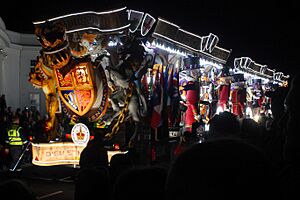
Weston has live music venues like "Scally's" and "the Brit Bar." The T4 on the Beach concert used to be held here every summer until 2012, featuring famous bands and singers. The beach also hosts the Weston-super-Mare Sand Sculpture Festival each summer.
The local band The Wurzels even sang a song called "Sunny Weston-super-Mare." Parts of the 1993 film The Remains of the Day were filmed in Weston, including the Grand Pier.
The Weston Arts Festival takes place every September and October, with many cultural events. Weston is also part of the November West Country Carnival circuit, where huge, brightly lit "carts" parade through the streets.
The town's weekly newspaper is The Weston & Somerset Mercury, which has been around since 1843. There are also online news sources like The Weston Echo. Local TV news comes from BBC Points West and ITV News West Country. In 2011, Weston Super Television, an online community television channel, was set up by volunteers.
The Sky1 TV show The Café was filmed in Weston-super-Mare. In 2015, the artist Banksy created a temporary art show called Dismaland at the old Tropicana.
In 2022, a retired gas platform called See Monster was turned into an art installation at the Tropicana. It was a unique project as part of a national art festival.
Sister City
Weston has a twin town in Germany called Hildesheim. They became sister cities in 1983.
Famous Places to Visit
The Grand Pier is one of Weston's most popular spots. It has funfair rides, a go-kart track, cafes, and arcade games. It was rebuilt after a fire in 2008 and reopened in 2010.
Weston's first pier, Birnbeck Pier, is on a small island north of the bay. It's currently closed to the public and its future is uncertain. The pier is also home to Weston-super-Mare Lifeboat Station.
Knightstone Island used to have a theatre and swimming pool. After being empty for years, it has been redeveloped with luxury apartments. You can take boat trips from here to Steep Holm and Flat Holm islands.
The Tropicana outdoor swimming pool was closed for a long time but now hosts events like the Funland amusement park in summer.
The First World War memorial in Grove Park was unveiled in 1922. It has a sculpture by Alfred Drury and lists the names of 402 men from the area who died in the war. It's a special historic building.
Places of Worship
Most of Weston's churches and chapels were built in the 1800s in a Gothic style. The old St John the Baptist church was rebuilt in 1824.
All Saints Church, built between 1898 and 1902, is a very important historic building. Holy Trinity Church is also a significant historic church. There is also a Greek Orthodox Church in Milton.
Sports in Weston
Football team Weston-super-Mare A.F.C. plays in the National League South at the Woodspring Stadium. They won the Southern League Premier South in 2022-2023.
There are two rugby clubs: Weston-super-Mare RFC, formed in 1875, and Hornets RFC, formed in 1962.
Somerset County Cricket Club used to play matches at Clarence Park until 1996. Weston-super-Mare Cricket Club plays at Devonshire Park Ground.
Weston is also famous for its annual motocross beach race every autumn. There are races for youth riders, sidecars, and quad bikes too.
Well-Known People from Weston
Many interesting people have lived in or come from Weston-super-Mare, including:
- A. V. Alexander, 1st Earl Alexander of Hillsborough: A government minister, he grew up in Weston.
- Jeffrey Archer: A famous author and politician.
- John Cleese: A well-known actor and member of Monty Python.
- Roald Dahl: The famous children's author, who attended school here.
- Jill Dando: A popular broadcaster and journalist.
- Arthur Stanley Eddington: An important astrophysicist of the early 1900s, who grew up in town.
- Rupert Graves: An actor, born and raised in Weston.
- Bob Hope: The famous comedian and actor, who lived here as a child.
- Hans Price: The architect who designed many of Weston's Victorian buildings.
- Paulo Radmilovic: An Olympic gold medal athlete.
- Michelle Terry: An actress and writer, born in Weston.
See also
 In Spanish: Weston-super-Mare para niños
In Spanish: Weston-super-Mare para niños








